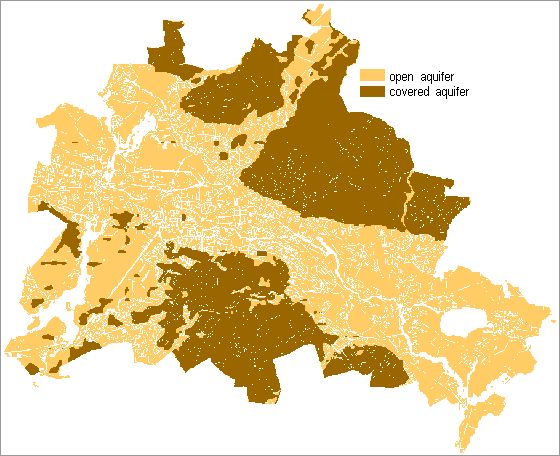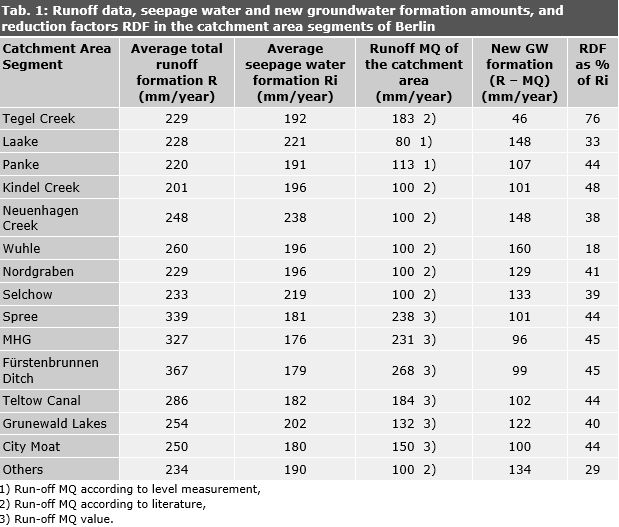The amount of new groundwater formation was calculated from the percolation rates according to the methodology suggested by Glugla (Glugla & Fürtig, 1997, Glugla & Müller, 1997, Glugla & Eyrich, 1993, Glugla & König, 1989, Glugla et al., 1999). According to Glugla (see above), for open aquifers, such as the glacial spillways and outwashes of northern Germany, the new groundwater formation corresponds to the percolation water formation; there, the following applies:
GWNB = Ri = P – Eta – Row
where
GWNB = new groundwater formation
Ri = percolation water formation
P = long-term mean annual precipitation sums
Eta = long-term mean actual evapotranspiration
Row = long-term mean surface runoff
However, in areas with covered aquifers, e.g. the ground moraines with glacial till or loam, only a part of the percolation water formation reaches the groundwater. In these areas, a part of the percolation water is carried away as near-surface interflow into bodies of water (receiving streams). Surface runoff and interflow together constitute the mean runoff MQ to the receiving streams. In areas with covered aquifers, the new groundwater formation can therefore be derived from the difference between the calculated total runoff formation (R = P – Eta) and the actual runoff MQ to the receiving streams which drain the area. In these areas, the following applies:
GWNB = Ri – Rzw
GWNB = P – Eta – Row – Rzw
GWNB = P – Eta – MQ
where
GWNB = new groundwater formation
Ri = percolation water formation
P = long-term mean annual precipitation sums
Eta = long-term mean actual evapotranspiration
Row = long-term mean surface runoff
Rzw =long-term mean interflow
MQ =mean runoff to the receiving streams ( = Row + Rzw)
Data on mean runoff to receiving streams in the catchment areas and their segments are an important basis for the calculation of new groundwater formation in areas with covered aquifers. These data are, however, only partially available. The data situation for the application of the method for the area of the State of Berlin must be considered difficult. Nevertheless, the method suggested by Glugla permits altogether plausible new groundwater formation rates to be calculated from the runoff and percolation water formation data.
For the determination of new groundwater formation rates, areas with covered and open aquifers were first distinguished, for only for the areas with covered aquifers does the new groundwater formation differ from the percolation water formation. The areas with covered aquifers were essentially derived from the Digital Map for the Characterization of Overburden, according to WRRL (SenStadt, 2002). Furthermore, all mapped areas with confined groundwater (p. Map 02.07) which extend beyond the areas of the above-mentioned map represented as “groundwater overburden” were certified as covered. Fig. 5 shows the areas distinguished for the determination of new groundwater formation rates according to open or covered aquifers.


